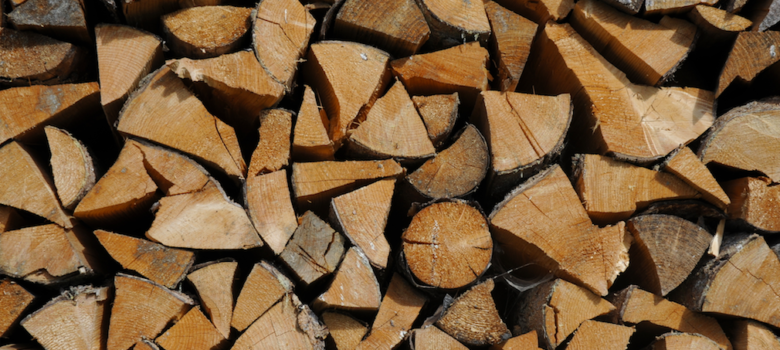
When people refer to biomass fuel, they are referring to biological material derived from living or recently living plants that can be used to create heat when burnt in a biomass boiler.
Biomass fuel is considered to be renewable
One of the key things about biomass fuels is that they are considered sustainable and renewable. The reason for this is that when they are burnt in the biomass boiler, the release of carbon dioxide only amounts to the same level they absorbed as plants/trees while they were growing.
Using this reasoning, one could argue that coal and gas are also renewable since they were once biological material – however it is really a question of timescale. Coal might take millions of years to form, while biomass fuels can take just a couple of years.
Fuel formats
Fuels generally need to be processed to be useful – some typical formats are:
- Logs – Commonly found in domestic to light commercial with daily input required.
- Bales – Manually fed batch firing with daily input.
- Chipped/shredded Fuel – Usually found with automated systems and on larger scale (over 50kW systems).
- Pellets – Typically found with smaller and urban systems due to their greater energy density.
- Woodworking offcuts/sawdust – Usually furniture offcuts and sawdust.
- Cereals/grains – Typically loose with little processing. Often found on our near farms for ease of transport.
Types of biomass fuel
Fuels can be seen as either wet or dry and high or low density. Wetter fuels will have a lower calorific value (i.e. less energy per kilo of fuel) and will be cheaper, but some moisture is usually desirable as some boilers don’t run as well with very dry fuel. Density is fairly straight forward – denser fuels will take up less space, but can be more expensive. Calorific value is also important, as some fuels will be dense but produce less energy than a less dense fuel with higher calorific content. The best measure of a fuel’s energy is ‘Energy Density by Volume’ or kWh/m3. This allows easy comparison between fuel types.
Virgin Wood – This includes any wood untreated with chemicals and finishes. Typically this comes from forestry and arboriculture, and commercial scale sources for the fuel market will be low grade, such as sawdust, bark or brash. Using virgin wood it is important to know the source of the fuel, as this could have repercussions for any environmental permits.
Energy Crops – This is not a big market in the UK but typically it involves short rotation crops, and could use any number of plants from fast growing trees like poplar to sugar and starch crops (beet, wheat or maize), to oil crops like rape and sunflower. Whatever the source, the fuel typically comes in a processed chipped form. With these fuels it is important to know whether the boiler is suitable for use with them.
Agricultural Residues – These systems typically require daily user input which can be a turn off for some, but for those with easy access to waste materials like wheat or barley straw, they can offer a very price competitive option.
Food Residues – Typically wet and can come from almost any food manufacturer in the form of oils, fruit and vegetables, distillery waste, and waste meat and fish.
Industrial Residues – This can include treated and untreated wood residues, like sawdust or dry wood chip. Consent is usually required for these kinds of boilers as the fuel must comply with environmental regulations. You must also be careful with the use of extremely dry materials as these can adversely affect a boiler that is not designed for use with the fuel.
Most popular types of biomass fuels
The two most common types of biomass fuel are wood pellets and wood chips.
Biomass wood pellets
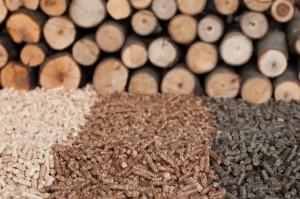 These wood pellets are normally about 10mm x 30mm in size and are manufactured from waste wood products. These compacted offcuts (from saw milling, wood manufactured products and waste wood found after logging), are compressed down into pellets along with a binding agent, often flour or corn starch, to prevent the breakup of individual pellets.
These wood pellets are normally about 10mm x 30mm in size and are manufactured from waste wood products. These compacted offcuts (from saw milling, wood manufactured products and waste wood found after logging), are compressed down into pellets along with a binding agent, often flour or corn starch, to prevent the breakup of individual pellets.
The pellets can be delivered in tankers (if demand is high). However most people order them by the bag, which will contain anything from 10kg – 1000kg.
They are a high-density, low moisture content biomass fuel, which enables them to be transported and stored efficiently and easily, with 1 tonne of the pellets only taking up 1.5 cubic meters of space.
The pellets tend to be popular for both smaller room stoves (often referred to as wood burners) and biomass boilers.
Since they are of uniform shape and size, they can be automatically fed into the heating system through an attached hopper. This allows pellet fuelled biomass boilers to perform on a timer system, much like traditional boilers, ensuring that you always arrive at a warm house.
Wood pellets tend to cost around £200 per tonne and 4.2p/kWh.
Wood chips
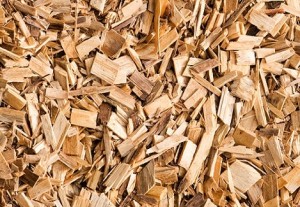
Wood chips are another very popular type of biomass fuel used in domestic biomass boilers.
The major advantage of wood chips over the other fuels is that they require minimal processing. Debarked logs are fed into specialised wood chipping machines, a less complex procedure than the manufacturing of pellets, and less manual handling that logs.
Due to their relatively high moisture content they do not tend to be as efficient in terms of transportation and storage as wood pellets, with 1 tonne of wood chips taking up a space of more than 2 cubic meters.
They are commonly used for boilers of a medium to large installation size. These occur in blocks of flats and office buildings. These wood chip biomass boilers, are incredibly efficient. However you will often find that some manufacturers don’t provide systems below 40kW.
Wood chips tend to cost around £100 per tonne and 2.9p/kWh (cheaper than the biomass wood pellets).
Wood Logs
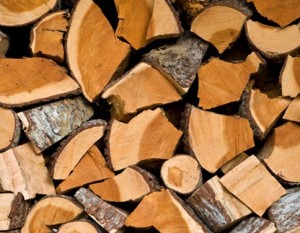
Wood logs are obviously the most readily available biomass fuel. After a tree is initially chopped, minimal processing is required and they are extremely easy to transport.
However, due to the minimal surface area of the logs, and their high moisture content, they have a much lower calorific value compared to either wood chips or biomass wood pellets. The calorific value is simply the amount of available heat per given volume of fuel.
The standard delivery commonly contains logs from newly-felled trees. This means that after a delivery you need to let them dry for a long period before they can actually be burnt efficiently; you need double the storage capacity when you are using logs as your primary fuel for your biomass boiler.
Therefore despite 1 tonne of wood logs taking up 2 cubic metres, you need to be able to store double that amount as you are letting the fresh logs dry out. This makes wood logs the least efficient biomass fuel to store.
The other issue with using logs in your biomass boiler is that due to their uneven size they cannot be fed into the boiler automatically. Instead, the user will need to put the logs in the burners by hand, which means that they are far more maintenance-heavy.
Despite their lower calorific value and the fact they are more awkward to handle, wood logs do tend to be very popular and are used across the UK to power a variety of stoves that heat individual rooms or biomass boilers that heat both the home and the water system. The reason being is that people who use them often have a free source of these logs to fuel their systems.
If you are going to have to buy your logs, we recommend searching around for the best deal since prices vary dramatically; however we recommend a guide price of about £150 per tonne.
Miscanthus – or elephant grass
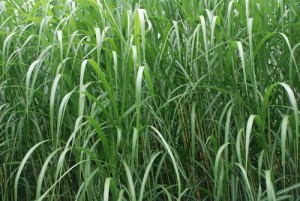
This low maintenance plant, in terms of nutritional needs, can be chopped or pelleted and in some cases can be used in typical wood chip or pellet boiler systems.
It is fast becoming an important biomass fuel in the UK as farmers have begun planting large crops on low-grade land.
We recommend that you check with your boiler’s manufacturer to make sure it is applicable with your system.
Miscanthus pellets tend to cost around £240 per tonne.
Factors affecting fuel cost
It is important to remember that the cost of a certain type of fuel will differ from one installation to another, for a number of reasons including:
Logistics – This includes distance from raw materials, delivery vehicle, frequency and volume of fuel required, discharge rates to move the fuel from the vehicle to storage.
Quality – Form of the fuel, calorific value, and quality of the fuel.
Market – Source of fuel, contract type (i.e. by weight, energy, volume etc.), quantity required, fluctuations in seasonal demand, and local demand.
Costs of biomass fuels
- Wood pellets tend to cost around £200 per tonne and 4.2p/kWh.
- Wood chips tend to cost around £100 per tonne and 2.9p/kWh so cheaper than the biomass wood pellets.
- Wood logs will cost about £150 per tonne.
- Miscanthus pellets tend to cost around £240 per tonne.











Thank you very much
Which Biomass is cost effective and energy efficient?
Where can I get “Miscanthus pellets ,,,, around £240 per tonne.”?
bonjour
j ai du switch Grass en production et je voudrais savoir si quel un a déjà mis ce produit en granulé pour le chauffage
avantage et inconvenients
qui peut me renseigner et aller visiter une installation
merci